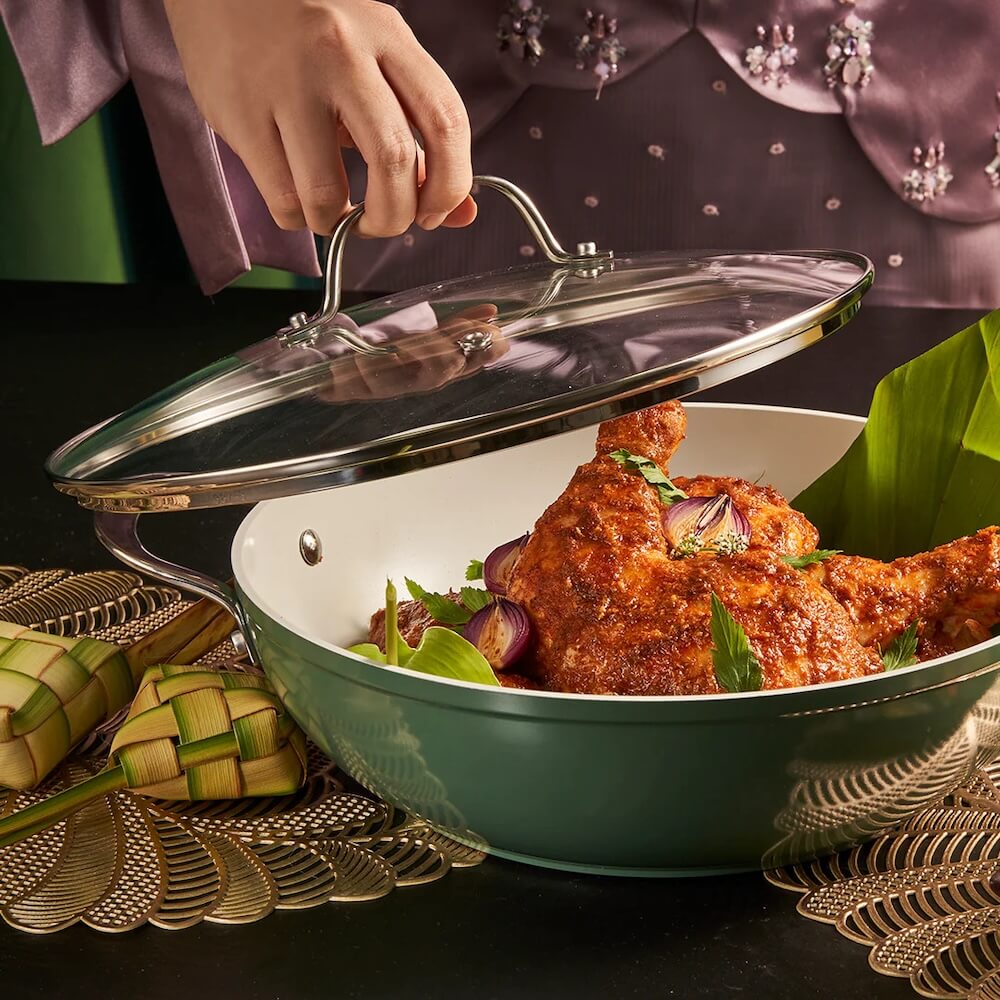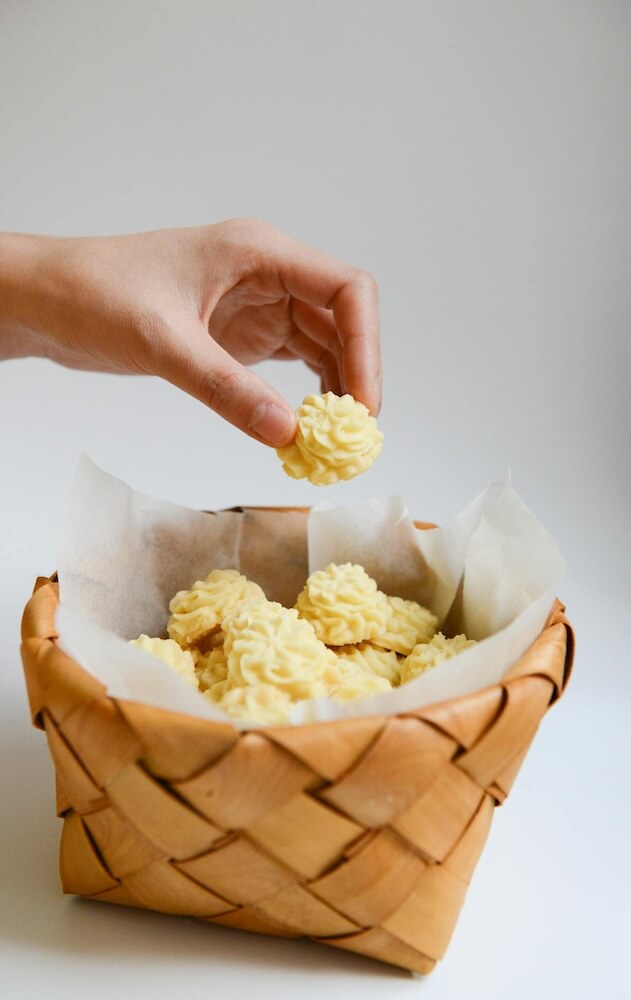Post-Ramadan Festive Feasts Are Not Complete Without At Least One Of These Essential Hari Raya Dishes!
Hari Raya Aidilfitri, regarded by many as Hari Raya in Malaysia, is the festive period that begins upon the end of the holy fasting month of Ramadan. It’s a time of joyful celebration with the spirit of forgiveness, renewal, and every Malaysian’s favourite…hearty feasting!
As families and friends gather from various parts of the world to the cultural melting pot of Malaysia to celebrate Hari Raya together, you’ll find that the air is slowly filled with the rich aromas of traditional Malay cuisine from your neighbours’ homes.
From traditional recipes that call for communal preparation to simple traditional foods that small families can easily recreate at home for their annual Hari Raya celebrations, let’s explore the essential Hari Raya dishes that truly set a delightful mood for Malaysia's Muslim community this festive season one serving at a time.
15 Essential Hari Raya Dishes That Are Commonly Enjoyed In Malaysia For The Festive Celebrations

1. Sayur Lodeh
Sayur Lodeh is a creamy and mildly spicy vegetable curry that is commonly served during Hari Raya. But over recent years, Sayur Lodeh has been enjoyed throughout the year alongside other daily dishes like plain steamed rice or lontong.
This vegetable curry stew has a rich, creamy taste with a yellow-ish appearance thanks to the coconut milk and paste of ground spices used to cook it. These spices typically include shallots, garlic, turmeric, and galangal.
While you’ll usually find vegetables like carrots, cabbage, green beans, and eggplants within Sayur Lodeh, some households add in extra protein like tofu or tempeh for a yummy protein boost.

2. Asam Pedas
Asam Pedas simply means sour and spicy once translated to English, true to how it literally tastes. While it’s not exclusive solely to Hari Raya with locals enjoying it year-round, most Malay households opt to serve it during their open house celebrations because it is a delicious local classic.
Asam Pedas features a slightly thick broth flavoured with tamarind juice, chilli peppers, and other spices such as turmeric, lemongrass, and galangal. It is then complete with a fish like mackerel or stingray, with the latter being the more popular option. This particular stew is best enjoyed with plain rice like how most locals enjoy their fish curry, where it is most delicious once soaked within the rice.

3. Ketupat
The humble Ketupat is synonymous with Hari Raya where it represents unity and harmony. Making Ketupat is a communal process that often sees family members and friends come together to make it, because it involves multiple steps starting with boiling the rice, weaving the coconut leaves together, followed by wrapping it up into its signature diamond-shaped form.

There are many variations to Ketupat like the Ketupat Pulut which is commonly found in northern Peninsular Malaysia and is made from glutinous rice and coconut milk, and the most common one being Ketupat Nasi, which is a plain steamed or boiled rice cake wrapped in woven coconut leaves.
This traditional Hari Raya dish is best enjoyed with rich, flavourful dishes like Rendang, Sayur Lodeh, or Asam Pedas to balance out their strong flavours with a satisfying texture.

4. Lemang (Glutinous Rice Cooked In Coconut Milk)
Lemang is a traditional Malay dish that is typically found only during the periods of Ramadan and Eid, but these days you may find the occasional roadside stall year-round selling this beloved dish.
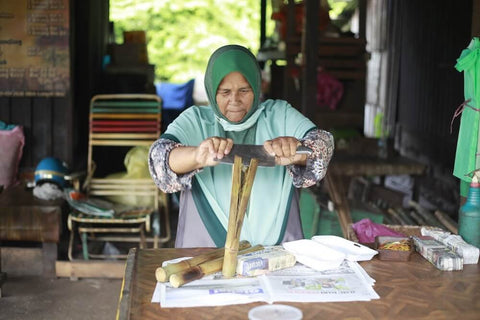
Though the Lemang may look simple, the process to make this sticky rice dish is a laborious and communal one that involves preparing hollowed bamboo sticks lined with banana leaves, then filling it with glutinous rice mixed with coconut milk and salt before lining it up over flaming charcoal fire to be roasted up to four to five hours.
This gives the Lemang its distinctive smokey yet creamy flavour that many adore, especially with Rendang. Which is why you’ll commonly find Lemang being sold alongside either Beef or Chicken Rendang!
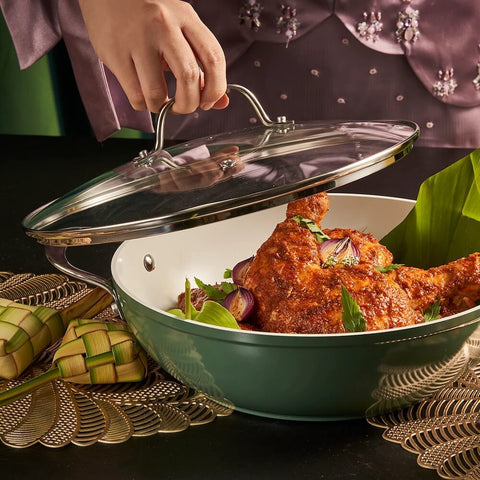
5. Rendang
Enter Rendang, Malaysia’s favourite dish for Hari Raya that not only embodies the richness of Malay culinary traditions, but it also bears a significance of reflecting the generosity and hospitality of the host.
Rendang may be one of the top essential dishes that are synonymous with Hari Raya, but this hearty stew is also savoured throughout the year for special occasions and gatherings in Malaysia.
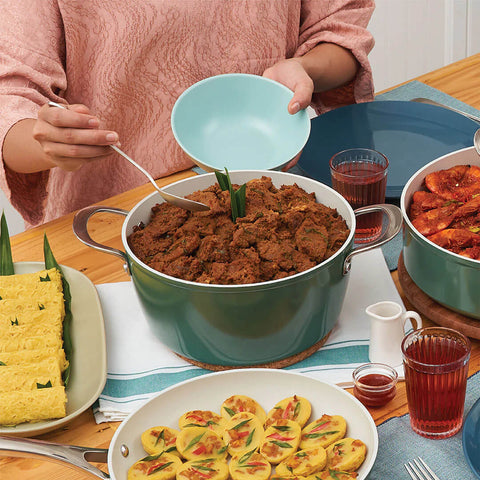
The delicious Rendang boasts a complex, robust flavour profile that is slightly sweet, highly savoury, and spicy. It usually comes with a type of meat, commonly beef for Beef Rendang or chicken for Chicken Rendang, which is slow-cooked in coconut milk and spices (think lemongrass, galangal, garlic, turmeric, chillies or dried chilli paste, and more) for several hours until you get its signature tender, rich, caramelised texture.
This traditional dish is best enjoyed with neutral dishes like freshly steamed rice, Lemang, or Ketupat which will complement the rich and complex flavours of Rendang. Just remember that Rendang is never crispy if you know what I mean! ;)

6. Dendeng
Dendeng is a type of dried meat dish that is very similar to jerky, only it’s served as a main dish during Hari Raya over being a snack like jerky. Dendeng is mostly enjoyed during Hari Raya and less so throughout the year because of the lengthy process involved in making it.
The flavours of Dendeng is a little complex as it is typically savoury, but some recipes make it a little sweeter and more caramelised by adding more of the kicap manis (sweet soy sauce) used to cook it. Dendeng is essentially made of thinly sliced meat that is marinated overnight in a blend of spices, black pepper, sugar, and sometimes tamarind, where it is dried and then stir-fried until it becomes crispy.
Dendeng can either be enjoyed as a snack or as an accompaniment to rice dishes like Lemang or plain white rice as a savoury and sweet contrast to the meal.

7. Lontong
Lontong may not be an exclusive Hari Raya dish, but it is definitely a regular dish served in Hari Raya open houses as part of the feasting spread offered by the host. Lontong is a mild, coconut-flavoured broth with a medley of vegetables like long beans, cabbage, turnips, carrots, tofu, hard-boiled eggs, compressed rice cakes (nasi impit), and sometimes a protein like chicken or beef.
But because of how the dish is made and served in Malaysia, it is often confused with Sayur Lodeh, which is essentially the Lontong stew without compressed rice cakes and meat.

8. Satay With Peanut Sauce
Widely regarded as one of Malaysia’s most popular street foods, the simple Satay scales even further in popularity during Hari Raya. Satay consists of meat like chicken, lamb, or beef that is marinated in a mixture of spices and sometimes coconut milk, which is then skewered and grilled.
Satay is traditionally grilled over charcoal to give it its signature smoky flavour, which is well complemented by its constant side dish - a sweet yet savoury spicy peanut sauce, and not forgetting the other sides of Ketupat or Nasi Impit (compressed rice cakes). The best peanut sauces are usually a rich sauce made from a combination of ground peanuts and chopped peanuts, coconut milk, chilli paste, and some sugar to give it a delightful burst of nuttiness.
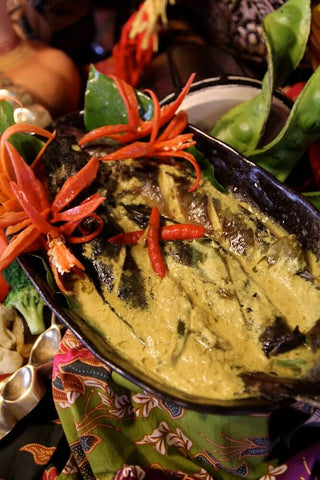
9. Masak Lemak
Masak Lemak is a traditional Malay dish that holds a place of honour during festive seasons, but it is also a staple in Malay cuisine enjoyed throughout the year. Masak Lemak is essentially a rich, creamy stew with a very slightly spicy flavour. Because of its mild flavour profile, Masak Lemak is commonly enjoyed by those who prefer milder and creamier curries.
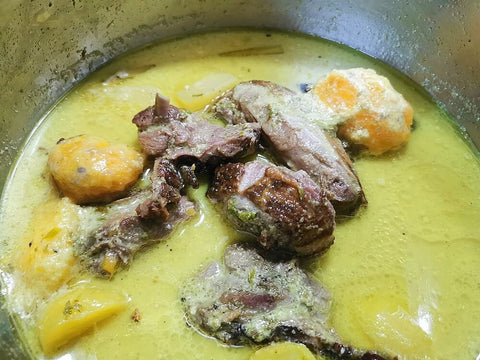
Masak Lemak is made by first boiling up a rich gravy of coconut milk, fresh turmeric, lemongrass, and chilli paste to make a velvety broth, then completed by cooking in beef, chicken, duck, or fish. But that said, there is a spicier alternative called Masak Lemak Cili Padi which sees the addition of bird’s eye chilli (cili padi) into the stew to make it spicier.
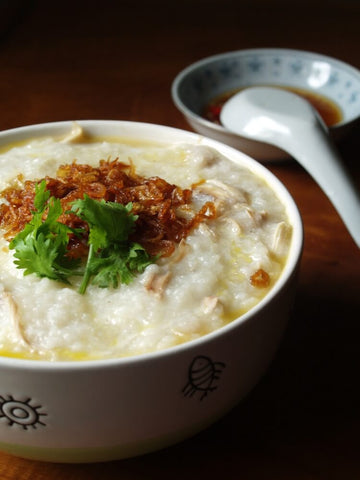
10. Bubur Lambuk
If there’s a dish that truly embodies community and generosity at its core, it is most certainly Bubur Lambuk. This humble dish is primarily associated with Ramadan and Eid because it is specially prepared by communities and distributed to charities, food banks, and mosques during this festive period to symbolise sharing and community support.
Bubur Lambuk is a flavourful and comforting porridge made with a blend of spices like cinnamon, cumin, ground coriander and sometimes ginger, coconut milk, and rice which gives it its soft and creamy texture. It also often comes with either beef or chicken, with the latter being the more common option.
11. Sambal Goreng
Sambal Goreng is one of the most popular accompaniments to Hari Raya spreads. Sambal Goreng essentially means fried sambal and it is a spicy dish that adds zest to the many dishes found at a Hari Raya feast.
This dish is often made with a mixture of fried ingredients such as ikan bilis, fried peanuts, long beans, tempeh, tofu, and vegetables in a thick, chilli-based sauce made from chillies, shallots, garlic, and sometimes shrimp paste, resulting in bright, spicy and savoury flavours with a hint of sweetness.
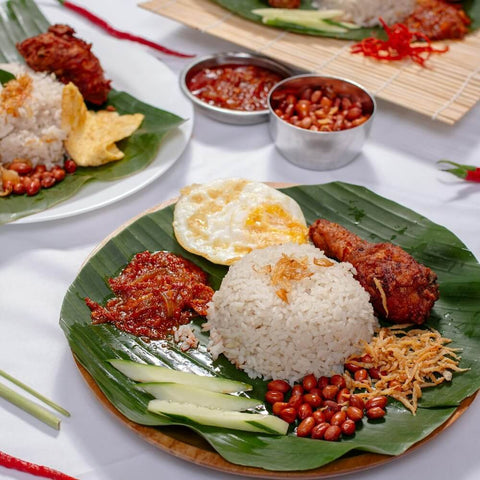
12. Nasi Lemak
Did you know that Malaysia’s national dish is also a Hari Raya feasting staple? Nasi Lemak can be enjoyed anytime, but even more so during Hari Raya when there are plenty of other dishes that pair deliciously well with it!
Nasi Lemak is a multi-part dish that consists of rice boiled in coconut milk and pandan leaves, a side of sambal (no, it isn’t Sambal Goreng), deep fried anchovies, peanuts, a few slices of cucumber, and a hard-boiled or fried egg. Some variations typically include a type of meat like fried chicken, beef rendang, or squid curry, with most of these being dishes that you’ll often find at Hari Raya spreads.

13. Serunding
If you’ve been to an open house before and wondered what that fluffy-looking dish next to the sambal was, then it’s quite likely that you saw a bowl of Serunding. Serunding is a spicy meat floss that is closely tied to Hari Raya as a traditional delicacy that showcases Malay culinary craftsmanship thanks to its intricate preparation and preservation process.
It’s also known as a popular sweet Indonesian dish that is prepared with cooked shredded meat, fried coconut flakes and a generous helping of coconut sugar. But in Malaysia, Serunding typically refers to meat floss that may or may not be mixed with grated coconut depending on how the host intends to serve it - a savoury or sweet-ish dish.
Serunding is commonly enjoyed with rice dishes like Ketupat and Lemang, sometimes even Nasi Lemak to give the otherwise neutral dishes an extra bit of texture and flavour. You'll also often find Serunding being sold by Rendang and Lemang sellers if you were wondering where to get it!
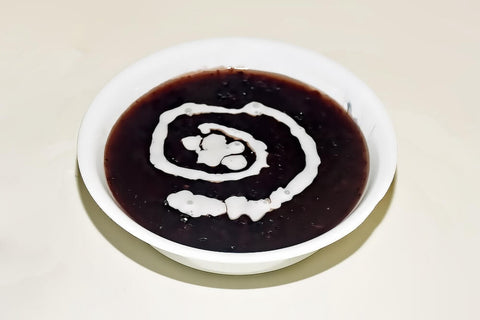
14. Bubur Pulut Hitam
Bubur Pulut Hitam literally translates to Black Glutinous Rice Porridge and it is a delicious traditional dessert that is often served during special occasions like Hari Raya. It is creamy, thick, and sticky in texture while being sweet, slightly nutty with bits of broken black glutinous rice, and comforting because it is typically served warm.
Bubur Pulut Hitam is made by boiling black glutinous rice together with some palm sugar or gula melaka and pandan leaves, then simmering it until it is reduced to a soft but thick soup. The dish is then served with a drizzle of coconut milk or coconut cream to give it an extra boost in creaminess which enhances its already delicious flavour even further.
It’s truly one of the best desserts to end your Hari Raya meal with after the spicy and heavy dishes found in most Hari Raya spreads.

15. Assorted Kuih Hari Raya
During Hari Raya in Malaysia, Malay cakes, pastries, and cookies are commonly referred to collectively as Kuih Hari Raya. This simple term bears a harmonious significance as it signifies the joy, diversity, and artistry of Malay baking traditions.
Even though assorted kuih can be found throughout the year in Malaysia these days (Nyonya Colors anyone?), there are a handful of Kuih Hari Raya that are exclusively tied to Hari Raya.
These types of Kuih Raya come in various flavours and textures. For instance, you have the sweet and creamy Kuih Pelita, a melt-in-your-mouth cookie like the Kuih Bangkit, the taffy-like Dodol, and the childhood favourite Almond London just to name a few. To find out more about kuih, check out our detailed article on the types of essential Kuih Raya found in Malaysia.

